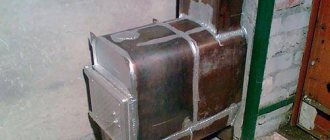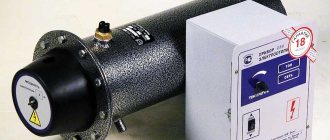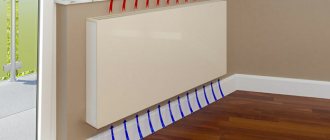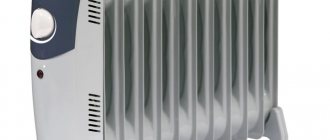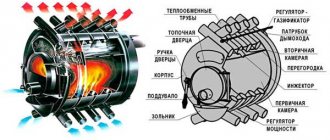Since ancient times, during the cold season, people have been looking for a way to heat their homes. For this purpose, heat from burning wood, peat and coal was used. With the development of the steam era, coal boilers and steam heating appeared. It became possible to separate the place of fuel combustion and the place of heating in space, this significantly increased the comfort in living quarters. The next revolution in heating occurred with the development of domestic gas. And finally, electric heaters appeared - the most efficient converters of electricity into heat today. One of the latest inventions is infrared heaters and their variety - micathermic.
Where is the best place to install a micathermic heater?
Micathermic heaters are ideal for:
- Country houses.
- Garages.
- Production sites.
- Any premises without central heating.
The following types of infrared heaters are distinguished:
- Cylindrical heaters emit waves in all directions at once. The mica plates inside the devices are arranged in a circle, so the room is heated evenly.
- Flat infrared heaters have a directional effect. The angle of radiation varies depending on the placement of the device. There is no mica lined on the end sides, so the heater does not propagate waves from the side plates.
- Wall heaters are manufactured flat. Thermostats, control units and other electromechanical sensors are mounted at the ends of the device. Some models of micathermic radiators are equipped with LCD monitors. The plates are made of nickel, which is stitched on both sides with tin or zinc oxide. Metals function as dielectrics and reflectors of heat rays.
- Ceiling heaters are mounted in the ceiling. Considering the light weight of the structure, lack of heating and ease of control, a micathermic radiator will perfectly cope with its function anywhere in space.
Specifics of infrared heater
The main component of a micathermic heater is a plate consisting of several layers coated on both sides with mica. The design does not require additional coolant for beam propagation.
The plate gives off heat, but does not heat up, which makes the device an excellent radiator in an apartment. Even if a person or animal accidentally touches the heater, no one will get burned.
The plates are enclosed in a metal casing, on both sides of which gratings are mounted.
- Through these holes, heat passes freely in two directions, warming objects around.
- Certain types of micathermic heaters have a more advanced design: a layer on one side reflects heat, and on the other it concentrates it.
- Heat flows in one direction, allowing the production of thin wall heaters with directional radiation.
A micathermic heater emits infrared radiation, which worries many buyers.
However, the infrared source inside the micathermic heat sink is enclosed in a mica housing, which significantly reduces the infrared flux and distributes it evenly. The radiation from a micathermic heater is completely safe for all living organisms.
Technical parameters of oil radiators
The oil radiator is a sealed tank filled with mineral oil, inside of which a heating element is installed. The ribbed configuration of the metal body allows you to increase the surface area that gives off heat through radiation, and also promotes the formation of air flows - the radiator releases part of the thermal energy through convection. The ratio of the two types of heat transfer is almost 50/50.
The electric tubular heater is equipped with a thermostat that allows you to control the operating temperature. The device is connected to a household power outlet with a voltage of 220 V.
The power of the unit depends on the model and ranges from 1 kW to 2.5 kW. One oil radiator is enough to heat a room with a volume of up to 25 m2. To increase the air temperature in larger rooms, you will need to install two or more devices of suitable total power. The radiator efficiency does not reach 100% due to heat losses when the oil heats up.
Modern oil heater
When choosing which heater is better, you should pay attention to the functionality of the models. It is worth comparing not an abstract radiator or convector, but device models with specific functionality
An oil heater may have:
- a protective casing on the body that prevents you from accidentally getting burned on heated metal;
- built-in fan that accelerates heating of the air in the room;
- rollover sensor - the device turns off the power supply to the device if it is tilted or falls;
- a timer that allows you to set the time to turn the heater on and off.
Oil-filled radiators are available in floor-standing, table-top and wall-mounted versions. Floor-standing models are equipped not only with a carrying handle, but also with wheels, which makes moving the unit around the house easier.
"Pros" of a micathermic heater
Like any electrical device, an infrared battery has its positive and negative characteristics. The “pros” and “cons” of a micathermic heater lie in its unusual structure.
Advantages of an infrared heater:
- Quick heating of the room.
- The absence of bulky coolants and spiral emitters makes it possible to significantly reduce the weight of the device.
- The plates are used only for the synthesis of infrared rays, but the plates themselves do not heat up. The operating temperature of the heater reaches 60 degrees Celsius. You can touch the heater when it is on without causing a burn to your skin.
- Safe for people and animals.
- Economical: energy consumption is 20-30% lower (compared to traditional heaters).
- Silent. Infrared radiation is produced and propagated silently.
- Does not reduce oxygen concentration.
- Mica from the plates does not emit harmful gases when heated.
- Mica is durable and does not allow water to pass through.
- Dust does not burn through the mica surface and a characteristic odor does not appear.
"Disadvantages" of a micathermic heater
- Ineffective over long distances. The farther from the radiator, the less heat.
- Warming is carried out only in the direction where the heater is directed. The rest of the room remains cool.
- Dust can clog the grille, making it quite difficult to clean.
- High cost (compared to oil analogues).
Selecting a heating device
The right choice of heating device will bring warmth and comfort to your apartment.
As you can see, oil convectors are leaders in many indicators, but fan heaters occupy a very specific stable niche among heating devices. To finally choose a specific heating device, watch video reviews on this topic.
User reviews
Reviews about micathermic heaters are positive. Users note the ability to warm up a limited space when there is no need to heat the entire room.
The infrared heater does not burn out the air, does not heat up and remains safe for installation in a children's room. A micathermic heater (unlike an oil heater) does not click during operation.
Buyers liked the light weight of the infrared heating radiator; it is easy to move around the apartment, installing it at the right points.
Operating principle
The main difference between a micathermic heater and oil, convector, and ceramic heaters is that it heats not the air in the room, but material objects that fall within their area of action:
- walls;
- floor;
- furniture.
Heating occurs due to energy radiation in the infrared light range. Infrared waves are invisible to the human eye, but can be felt by the skin as a flow of heat. It feels like the effect of bright sun in calm weather. Calculations show that the device converts up to 80% of consumed electricity into radiation. The remaining 20% is not lost, it is spent on heating the air next to the device. So every infrared heater is also a little convection.
Operating principle of a micathermic heater
Convection heaters primarily heat their surface, which transfers heat to the air in contact with it. The heated air rises, gradually cools there, giving off heat to the ceiling and walls, and falls down. There it heats up again from the surface of the radiator, rises up, and the cycle repeats. Thus, natural air circulation is established, and all the air in the room is warmed up. If the convection heater is equipped with a fan, the heating speed from several hours is reduced to 15-30 minutes.
A micathermic heater also copes with warming up the room during this time, but it becomes comfortable next to it from the first minutes of switching on.
Manufacturers of micathermic heaters
- VES MX 1 is perfect for production facilities and garages. Heating is carried out 360 degrees, covering all zones. The radiator is produced in Asian factories, the average cost of the product is approximately 3.8 thousand rubles. The infrared device has a built-in automatic shutdown function if dropped.
- DeLonghi with two types of installation: on wheels or wall mounting. The heater's power is enough to warm up 30 sq.m. Heater weight is about 4 kg. Cost about 4 thousand rubles.
- The Polaris micathermic heater on wheels makes it easy to move the device around the apartment. Maximum heating area – 30 sq. m. Heater weight – 4.5 kg. It works quietly (without crackling or clicking).
The market offers a wide range of infrared heaters. It is enough to decide on the color scheme and appearance of the micathermic radiator.
Popular models with brief characteristics and prices
GoldStar EPH-7101
GoldStar EPH-7101
A well-known Korean company assembles this model at factories in China. Traditional quality is complemented by a relatively low price. For it you can get a two-stage power regulator and a mechanical thermostat. The power of the device is 1 kW, which is enough to heat 12 square meters. Price – 3,740 rub.
Polaris PMH 0115 5E
Polaris PMH 0115 5E
A more powerful (1.5 kilowatt) model from an American manufacturer is also assembled in China. It is made in a horizontal design, equipped with a two-stage mode selector and a mechanical thermostat. The device can heat an area of 15 m2. The heater costs 4,299 rubles.
Polaris PMH 1584
Polaris PMH 1584
A more advanced 1.5 kW device is equipped with a smooth electronic power regulator. Due to the improved design, the heater can cope with an area of up to 18 m2. The delivery set includes wheels for easy movement around the room. The heater will cost 4,799 rubles.
Galaxy GL 8228
Galaxy GL 8228
The budget micathermic heater from the Chinese brand Galaxy has a decent power of 2.2 kW. It is equipped with a mechanical switch and thermostat and will heat a room up to 22 m2. A simple and reliable device costs RUB 2,659.
De Longhi HMP1500
De Longhi HMP1500
Despite the big name, the device combines high quality and efficiency with a relatively affordable price. It is equipped with an electronic system for maintaining a set temperature, which controls the device with high precision and allows you not to waste unnecessary electricity.
During the design, special attention was paid to security systems. The controller constantly monitors the surface temperature of the casing and the position of the device in space. If the surface overheats or the device overturns, it automatically turns off.
The delivery set includes brackets for wall mounting and wheels for floor mounting. They allow you to move the heater to the desired location without any extra effort. Unit power – 1500 watts, price – 4,790 rubles. The manufacturer recommends using it for heating rooms up to 18 m2.



